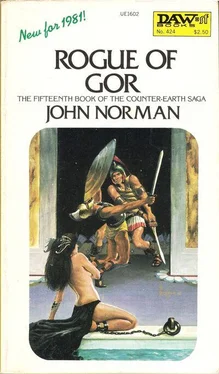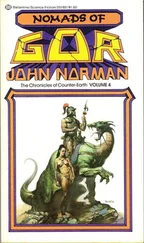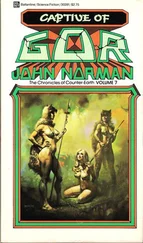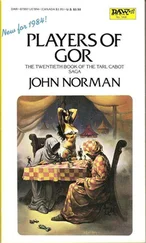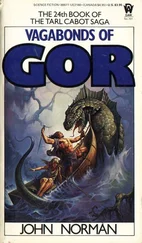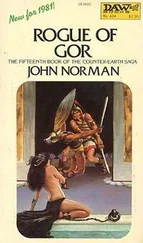I turned away and gave my attention to the slave writhing on the tiles before us.
She was performing a need dance, of a type not uncommon among Gorean female slaves. Such a dance usually proceeds in clearly defined phrases, evident not merely in the expressions and movements of the girl but in the nature of the accompanying music.
There are usually five phases to such a dance. In the first phase the girl, dancing, feigns indifference to the presence of men, before whom, as a slave, she must perform. In the second phase; for she has not yet been raped, her distress and uneasiness, her restlessness, her disturbance by her sexual urges, must become subtly more manifest. Here it must be evident that she is beginning to feel her sexuality, and drives, profoundly, and yet is struggling against them. Toward the end of this phase it must become clear not only that she has sexual needs, and deep ones, but that she is beginning to fear that she may not be, simply as she is, of sufficient interest to men to obtain their satisfaction. Here, need, coupled with anxiety and self-doubt, for she has not yet been seized by strong men, must become clear.
In the third phase of the dance she, in an almost lady-like fashion, acknowledges herself defeated in her attempt to conceal her sexuality; she then, again in an almost lady-like fashion, delicately but clearly, with restraint but unmistakably, acknowledges, and publicly, before masters, that she has sexual needs. Then, with smiles, and gestures, displaying herself, she makes manifest her readiness for the service of men, her willingness, and her receptivity. She invites them, so to speak to have her. But she has not yet been seized by an arm or an ankle, or by her collar, a thumb hooked rudely under it, or hair, and pulled from the floor. What if she is not sufficiently pleasing? What if she is not to be fulfilled? What if she must continue to dance, alone, unnoticed?
At this point it becomes clear to her that it is by no means a foregone conclusion that men will find her of interest, or that they will see fit to satisfy her. She must strive to be pleasing. If she is not good enough she may be chained, unfulfilled, another night alone in the kennel. There are always other girls. She must earn her rape. Too, if she should be insufficiently pleasing consistently it is likely that she will be slain. Goreans place few impediments in the way of the liberation of a slave female’s sexuality. In this phase of the dance, then, shamelessly the woman dances her need and, shamelessly, begs for her sexual satisfaction. This phase of the dance is sometimes known as the Heat of the Collared She-Sleen.
The fifth, and final phase, of the dance, is far more dramatic and exciting. In this phase the girl, overcome by sexual desire and terrified that she may not be found sufficiently pleasing, clearly manifests, and utterly, that she is a slave female. In this portion of the dance the girl is seldom on her feet. Rather, sitting, rolling, and changing position, on her side, her back, her belly, half kneeling, half sitting, kneeling, crawling, reaching out, bending backwards, lying down, twisting with passion, gesturing to her body, presenting it to masters for their inspection and interest, whimpering, moaning, crying out, brazenly presenting herself as a slave, pleading for her rape, she writhes, a piteous, begging, vulnerable, ready slave, a woman fit for and begging for the touch of a master, a woman begging to become, at the least touch of her master, a totally submitted slave. The fourth phase of the dance, as I have mentioned, is sometimes known as the Heat of the Collared She-Sleen. This portion of the dance, the fifth portion, is sometimes known as the Heat of the Slave Girl.
“I had expected the topaz to be delivered earlier,” said Policrates. “I had sent word to Ragnar Voskjard more than fifty days ago.”
“There were many deliberations in the holding of Ragnar,” I said. “Junctions of this kind are not to be entered upon lightly. Too, I was detained in Victoria. There are many guardsmen in Victoria, both of Port Cos and Ar’s Station, who search for the bearer of the topaz.”
“I would feel better,” said Kliomenes, “if I could see your face.”
“The mask I wear,” I said, “must be to conceal my identity.”
“It is common, Kliomenes,” said Policrates, “for the courier, he carrying the topaz, to cover his features in foreign holdings. The concealment of his identity is essential to his work.”
“For all you know,” I said to Kliomenes, “I might be Ragnar Voskjard himself.”
Kliomenes shrank back.
“But you are not,” said Policrates, “for Ragnar, a shrewd fellow, would not venture upon such dangerous work as the personal transport of the topaz.”
“I think that is true,” I grinned. “At any rate it is certainly true, at least, that I am not Ragnar Voskjard.”
“There is something about you which seems familiar,” said Kliomenes. “Have I ever seen you before?”
“Perhaps,” I said.
“You see, Kliomenes,” said Policrates, “our friend may be well known upon the river. If so, it is scarcely in Ragnar Voskjard’s interest, or in ours, or in the interest of our friend here, to be recognized as the courier of the topaz. If he is highly placed in some town on the river then his utility to Voskjard and to us would be considerably diminished if it were understood such a highly placed person was secretly in league with men such as ourselves and Voskjard.”
“True,” said Kliomenes.
“And I think we may be certain,” said Policrates, “that our friend is indeed well known in at least one town on the river.”
“That is true,” I admitted. Indeed, I was reasonably well known in Victoria.
The music ended with a swirl of sound and the girl, with a jangle of bells, lay before the table of Policrates, whimpering, her hand extended. She lifted her head. I read the unmistakable need in her eyes. She was indeed a slave female.
“Master!” she whimpered. “Please, Master.”
Policrates glanced at her. He had scarcely paid her attention in the dance.
“Throw me to your men, please, Master,” she begged.
Policrates gestured to a brawny fellow who, coming up behind the girl, bent down and, by her upper arms, lifted her from the floor. She was helpless in his arms. Only her toes, with painted, scarlet nails, touched the floor. Policrates gestured again, to a table to the side, and the fellow, carrying the girl, went to the table. He then threw her, with a jangle of bells, and a clatter of plates and goblets, to the surface of the table. Instantly the girl was held down on the table, on her back, her arms and legs held apart, and several men crowded about her. I heard her cry out with pleasure.
“I know who you remind me of,” said Kliomenes.
“Who?” I asked.
“A brawler and dock worker of Victoria,” he said, “one called Jason.”
I smiled.
“There is a resemblance,” said Policrates.
“Jason, of Victoria,” said Kliomenes, “did not know the sword.”
“Then how could I be he?” I asked.
“Draw!” cried Kliomenes, leaping across the table, and whipping out his blade.
I looked, unconcernedly, at Policrates. “My identity is surely established sufficiently by my former possession of the topaz,” I said. “Surely, too, none who were not of the party of Ragnar Voskjard, should they come into the possession of the topaz, would dare to bring it here. What could be the point?”
“These things seem to me true,” said Policrates, “but, as Kliomenes has said, there seems a resemblance.”
“Surely I am not to be blamed for that,” I smiled.
“Will it hurt to make test of the matter?” inquired Policrates.
I grinned. “No,” I said. “But, on the other hand, it is well known upon the river that Kliomenes is an excellent swordsman. Surely I should be forgiven if I do not find myself eager to be spitted upon his blade.”
Читать дальше
